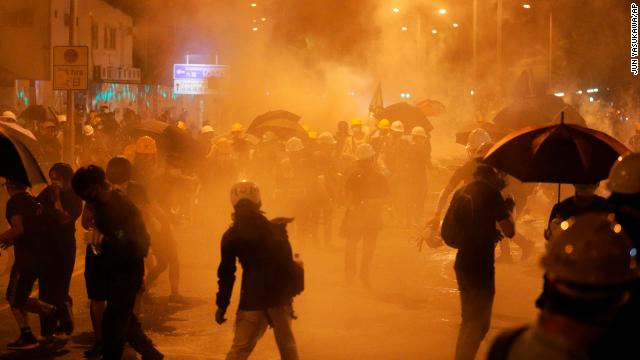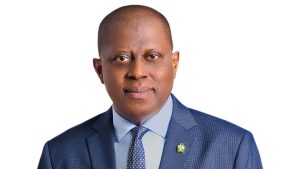Hong Kong government building a ‘big crime scene’ after night of violent protests

Graffiti-scrawled slogans, broken glass and strewn debris were just a few of the outward signs of a night which marked an apparent turning point in the city’s weeks-long protest movement against a controversial extradition bill. On Tuesday, the main entrance to Legislative Council (LegCo) — which only 24 hours earlier had been a hub for napping protesters — had been cordoned off with blue-and-white police tape. At a press conference near the smashed building facade, LegCo President Andrew Leung said police are now in control of the building and carrying out investigative work. “Right now, LegCo is a big crime scene,” he said. “The priority of LegCo is to get in shape to have meetings. It will be very difficult to use this venue for LegCo.” Leung expressed sadness at the use of spray paints to vandalize the main chamber, where lawmakers debate and pass laws. On Monday, hundreds of thousands of peaceful demonstrators marched through the city on the anniversary of Hong Kong’s 1997 handover to Chinese rule. But before the main march got underway, a small, breakaway group of protesters — many of them in their teens and twenties and wearing masks, helmets and other protective gear — went to the LegCo complex. Outside the building, local pro-democracy lawmakers pleaded with protesters to exercise restraint, but to little avail. Using makeshift battering rams and metal bars to smash through reinforced glass, members of the group were eventually able to force their way into the Legislative Council, where they dubbed anti-extradition bill slogans on the walls, smashed the interior and draped the territory’s former colonial flag across the main chamber’s central podium. Police did not act as protesters attacked the building or stormed inside, and hundreds were able to remain in the legislature for up to three hours before word of an imminent clearance operation brought them back onto the streets. Within minutes of protesters taking a collective decision to exit the building — even dragging some who wanted to stay and face the consequences out against their will — police fired tear gas and used baton charges to disperse the crowd. In an early morning press conference Tuesday, Hong Kong’s leader Carrie Lam condemned the protesters’ actions, saying they had used “extreme … violence and vandalism.””Nothing is more important than the rule of law in Hong Kong,” she told reporters.The Chinese government reaction to the protests has been similarly critical. A spokesman for the State Council’s Hong Kong and Macau Affairs Office said that the “radical” demonstrations had been an “open challenge” to the city’s system of governance.”This kind of severe illegal action damages Hong Kong’s rule of law, social order and hurts Hong Kong’s fundamental interests,” the statement said, adding that Beijing was fully behind the city’s police force.A day of demonstrationsJuly 1, the anniversary of Hong Kong’s handover from British to Chinese rule, has always been marked by pro-democracy marches.This year, turnout was expected to be boosted by continued anger over a proposed law that would allow extradition to China, which has brought hundreds of thousands of Hong Kongers into the streets, eventually forcing the government to suspend the bill. ]]]]>]]>Critics fear the law could be used to seize government critics and send them across the border to face trial in a system with a 99% conviction rate and a history of political prosecutions. Lam reiterated Tuesday there are no plans to restart the suspended legislative process before the bill expires with this term of the city’s parliament.From early Monday morning, however, growing divides within the protest movement came to the fore, as a hard core of mostly young, masked protesters laid siege to the legislature, hours ahead of when the traditional march was due to begin. Their actions come after repeated wildcat protests, many targeting police headquarters in anger over violent clearance operations during previous protest on June 12. As clashes have continued, protesters’ demands have expanded from full withdrawal of the extradition bill and investigation into allegations of police brutality, adding calls for full universal suffrage for elections of the city’s leader and legislative council, which were the goals of the 2014 Umbrella Movement. The use of direct action by the protesters has shocked many in Hong Kong, and it is unclear whether protesters will continue to enjoy public support following the break-in — or what steps the government will take to quell any further demonstrations.Protesters CNN spoke to at the main march on Monday were unwilling to outright condemn the actions of those attempting to break into the government building.”Some of us are more radical, some of us just want to walk,” said Tsang, a 24-year-old university student who also took part in a march in June. “We are the same team, so we don’t want to go against them.”On Tuesday, bystanders around LegCo had mixed reactions to the previous night’s events, although everyone CNN spoke to expressed some degree of sympathy with the protesters. Wong, a finance worker in her forties who was on her lunch break, said she felt sorry for Hong Kong’s young people, who didn’t have the same opportunities she did when she was their age. “The young people might not be doing the best thing, but we are not giving up on them,” she said.A middle-aged man who did not wish to give his name expressed disapproval. “What happened last night is heart-breaking,” he said. “I don’t mind peaceful protests, but I stand firmly against violence.”Support in doubtMany in the city were shocked at both the protesters’ anger and rapid escalation, and the hands off approach taken by police, whose apparent reticence to combat protesters until they had wrought chaos inside the legislature has led to criticism from pro-democracy lawmakers. “This was a trap,” pro-democracy lawmaker Fernando Cheung said Monday night. “The police did not do anything, they wanted this to happen, they wanted the public to see this.”His colleague Claudia Mo said Tuesday that the government has been trying to “turn the tables around, shifting the public anger.” “The problems (the protesters) raised have been so deeply-rooted in Hong Kong,” she said. “I should think the majority can still see through the political facade of Carrie Lam’s and she’s not going to make it.”While protesters had agreed to go and offered scant resistance, the police clearance operation in the early hours of Tuesday was exceptionally fast, with officers baton charging the crowd while others fired tear gas over their heads, showing they were more than capable of handling the numbers around the building. Police have since pushed back on the insinuation. “We had officers inside the LegCo defending LegCo for nearly eight hours,” Hong Kong Police Commissioner Lo Wai-chung said during the early-morning press conference. “During the period, we had been under siege of the protestors … several incidents happened that made us to do a temporary retreat,” he said, adding that police were afraid of being attacked by “toxic powder” allegedly thrown by the protesters.In total, 59 people were sent to hospital during Monday’s protests. As of 8 a.m., six people were in a stable condition and three people were in a serious condition, according to Hong Kong’s Hospital Authority. Police said 13 police officers were hospitalized, although it was not clear whether the police injuries were included in the Hospital Authority’s count. Several protesters were seen to keel over from the intense heat and humidity. It is unclear how many arrests have been made or if police are planning operations Tuesday. While most protesters were masked, several could be seen at times without face coverings. Leung, the LegCo president, said that police were “gathering evidence.” CNN’s Natalie Leung contributed to this story






